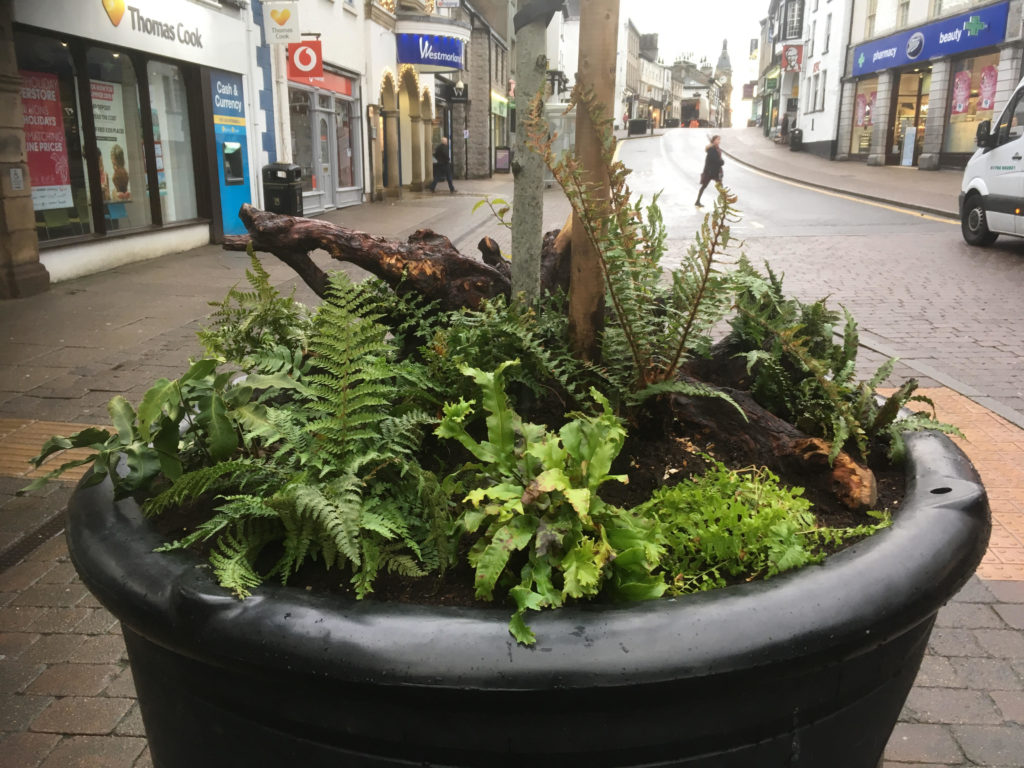Our story of sustainable (and not so sustainable) development told in plant form. Using displays of native plants to illustrate facts and stories about our ever changing local landscapes: how we have benefitted from them and changed them over time.

Tropical Kendal: 300 million years ago
Return of the Forests after the last Ice Age: 12,000-6,000 years ago
What did the Roman’s do for Kendal? From AD 95 to AD 410
The Natural Health Service – From the Dark Ages (AD 500) to the NHS (1948)
Noble’s Rest Coppice – a Medieval DIY Superstore
The Legend of Richard de Gylpin and the Wild Boar Reign of King John (1199-1216)
Kendal Green: A Legend in the Making
Spindle Wood – A Sleeping Beauty? : Medieval Kendal – about AD 1500.
The Limestone Blues and Greys : 1767
Victorian Fern Mania: 1850-1900
Kendal’s Legendary Landscape Trail provides an insight into what the land around us looked like before people lived here and how and why it changed during the thousands of years after they arrived. We are using plants that are symbolic of those times to transform planters, odd-corners and other small areas of Kendal into chapters in the long story of our changing landscape. For example, we use a lot of ferns to symbolise our woodland habitats.

In the 1800s Kendalians were at the centre of national craze for collecting ferns.
What’s it all about?
It all started as a joint project between the Kendal Conservation Volunteers and Kendal Town Council and many other individuals, groups and organisations across the area are now involved. It began in Spring 2018 with the restoration of the Victorian Fern Garden in Serpentine Wood and was soon extended to planters and other spots around the Town.
The trail will connect residents and visitors with the history, heritage and natural environment of the town. It will use plants (and a few animals) to highlight changes from pre-historic to current times and perhaps even into the future. The displays will range across millions of years from: primeval tropical forests, ice-age Britain, to the time of hunter-gathers, to the beginnings of agriculture and bronze-age stone-circles in the bronze age, to what the Romans did for Kendal, to the days of enchanted forests, to paganism and magical plants, to the coming of Christianity, to the Town’s coming of age during the medieval period and then through periods of rapid change when successive revolutions in agriculture, industry, transport and leisure lead us through to modern times and beyond.
It’s the story of our people and the way in which they lived in the landscapes around them. And it’s a chance to consider what kind of landscape we should be creating for future generations. Getting started: the trial trail. The Trail of displays is currently being tested in small planters in and around the Town centre and some larger odd-spots. These illustrate our connection to lost forest landscapes and put ferns centre-stage to create a time-series spanning 300 million years from the time when the land on which Kendal now stands was on the equator, through the last ice age and then onto Victorian Times to celebrate Kendal’s connection to the national craze for collecting ferns. Obviously there are big time-gaps between the dates on our three planters but many stories remain to fill them.
What is in the plant displays?
We’re creating simple displays using mainly native species that reflect local landscapes from a specific date, event or time period in the history of Kendal. According to the theme, the main components of each display/planter are chosen from: mixtures of wintergreen and deciduous ferns to provide all round interest, companion plants to provide contrast and splashes of colour across spring and summer and, perhaps, trees and shrubs. In most cases, centre pieces have been added to provide historical context. For example, these could be wood sculptures, geological features or archaeological and industrial artefacts.
Features of the Trail
- The Landscape Trail is based on:
- A new horticultural challenge:
- The use of mainly native plants such as ferns to symbolise natural and man-made landscapes through the ages. It will cover landscapes such as forests and fells and many others created by human activities in fields, hedgerows, roads and railways.
- A new approach to providing facts about Kendal’s history and environment.
- Informative and fun insights into past and possible future landscapes.
- Environmental responsibility:
- Key messages about change & “sustainable development” over the ages illustrating how social and economic changes have gone hand in hand with changes to our environment.
- Learning from our landscape history to understands the implications for our future earth as we respond to the challenges of global change.
- Sustainable planting through use of native perennial species and low-cost management.
- Partnerships and community participation:
- Already contributing: Kendal Conservation Volunteers, Fellside Forum, North West Group of British Pteridological Society, Kendal Town Council, Sandylands Residents Association, Friends of Noble’s Rest.
- Using information from: Kendal Civic Society, Kendal Library, Kendal Museum, Kendal Archive Centre and many other sources.
- Further contributions encouraged from: schools, local businesses and other community groups.
- Please feedback comments and ideas for other planters to Kendal Conservation Volunteers.
